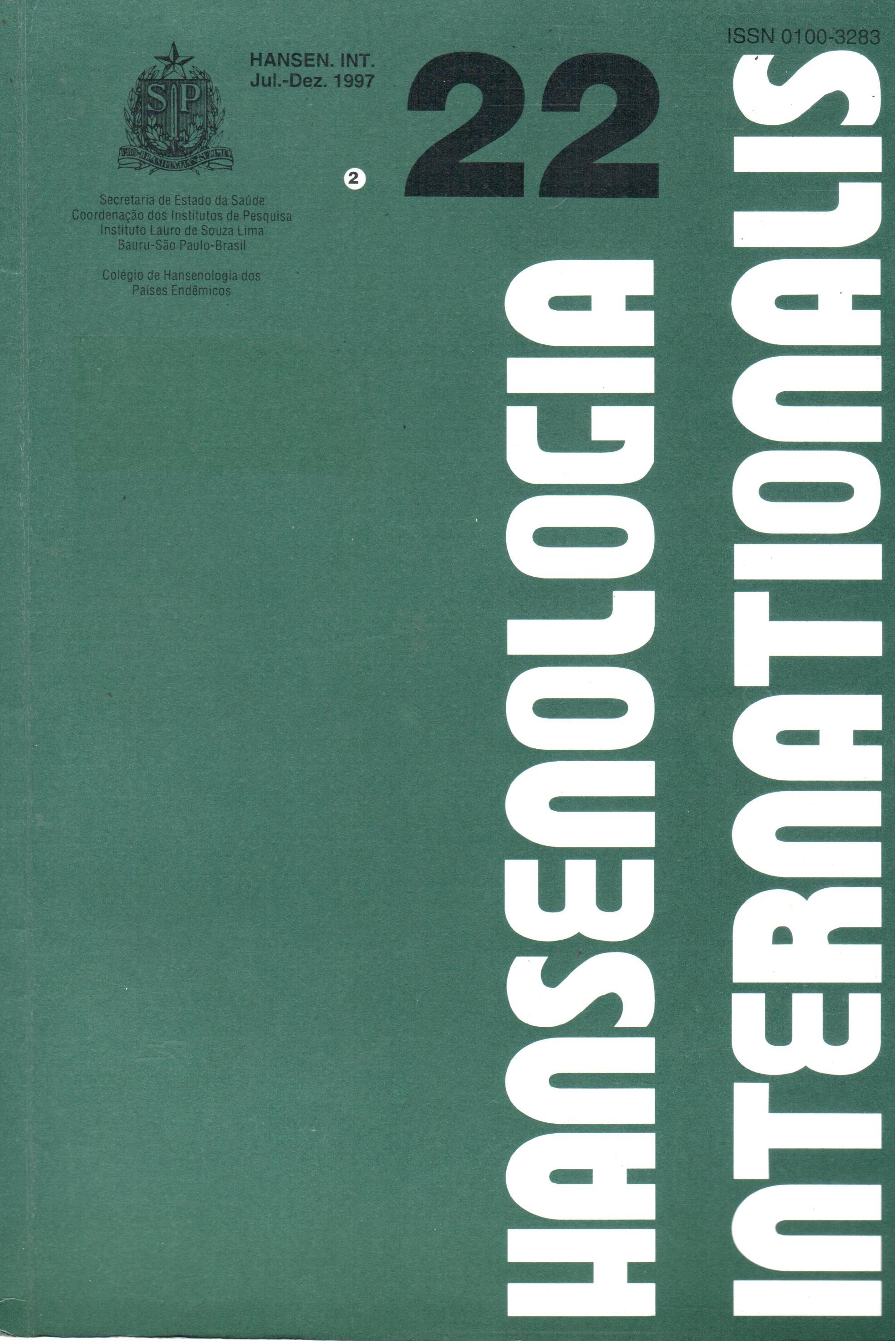Abstract
In the literature there are reports that the proliferation of M. leprae in viscera could occur even in the absence of proliferation at neuro-cutaneous level, and this fact could allow reactivation of leprosy. We analyzed 60 necropsies of lepromatous leprosy patients to compare and contrast from several visceral sites with those from skin and peripheral nerves. The necropsies were divided in groups according to results of the last baciloscopy done while the patients were alive: active lepromatous and in progression — 15 necropsies; active lepromatous and in regression — 17 necropsies; inactive lepromatous — 28 necropsies. In some necropsies, the visceral bacillary index overpassed the same index at neuro-cutaneous level, and in 3 necropsies, typical bacilli were found only in viscera (larynx and testicles). These results couldn't be appraised because technical and legal limitation prevented us from collecting skin and peripheral nerve fragments from various sites. Nevertheless, some reports suggest that the baciloscopy of skin drainage lymphonodes can be an estimate of cutaneous baciloscopy. In some of the visceral necropsies examined the bacillary index surpassed the same index in the axillary lymphonodes. Except for the axillary lymphonodes, the highest visceral bacillary indexes were found in the larynx, testicle and pharynx, with predominance of the first site. This may reinforce the relationship between tissue temperature and bacillary proliferation ability, suggesting that the larynx presents conditions of adaptation and proliferation of M. leprae, similar to the nasal mucous, which is the main via of bacillary shedding.
References
BARTON, R.P.E. Lesions of the mouth, pharynx and larynx in lepromatous leprosy. Leprosy in India, v.46, p.130-134, 1974.
BARTON, R.P.E. Ear, nose and throat involvement in leprosy. In: HASTINGS, R.C., ed. Leprosy. Endinburgh: Churchill, p.243-252, 1985.
BERNARD, J.C.; VAZQUEZ, C.A.J. Visceral lesions in lepromatous leprosy. Study of sixty necropsies. Int. J. Leprosy, v.41, p.94-101, 1973.BRAND, P.W. Temperature variation and leprosy deformity. int. J. Leprosy, v.27, p.1-7, 1959.
CHACKO, C.J.G. Evolution of leprosy lesions in man. In: INTERNATIONAL LEPROSY CONGRESS,13, Haia, 11-17 september,1988.
COCHRANE, R.G. Signs and symptoms. In: COCHRANE, R.G., DAVEY, T.F. Leprosy in theory and practice 2nd ed. Bristol: Wright & Sons, 1964. p.251-274.
DESIKAN, K.V. Viability of M. leprae outside the human body. Lepr. Rev., v.48. p.231-235, 1977.
DESIKAN, K.V.; JOB, C.K. A review of post-mortem findings in 37 cases of leprosy. Int. I. Leprosy, v.36, p.32-44, 1968.
DRUTZ, D.J. et al. The continuous bacteremia of lepromatous leprosy. New Engl. J. Med., v. 287, p.159-164, 1972.
FITE, G.L. Leprosy from the histologic point of view. Arch. Pathol., v.35, p.611-644, 1943.
FLEURY, R.N. Doenças bacterianas. In: SILVA, I.M. da Dermatopatologia. Rio de Janeiro: Atheneu, 1983. p.99-100.
FLEURY, R.N. Manifestações sistêmicas. In: TALHARI, S., NEVES, R.G. Hanseníase Dermatologia Tropical. 2a ed. Manaus: ISEA, 1989. p.73-77.
FLEURY, R.N.; OPROMOLLA, D.V.A. Hanseníase virchoviana, fenômeno de Lúcio e criptococose. Hans. Int., v.13, p.47-55, 1988.
GARCIA, R.B. Avaliação do comprometimento específico das principais cadeias de linfonodos na hanseníase. Bauru: USP, 1981. Tese (doutorado) Faculdade de Odontologia.
J08, C.K. Gynecomastia and leprous orchits. A preliminary study. Int. I. Leprosy, v.29, p.423-440, 1961.
KHANOLKAR, V.R. Pathology of leprosy. In: COCHRANE, R.G., DAVEY, T.F. Leprosy and theory and practice. 2nd ed. Bristol: Wrigth & Sons, 1964. p.125-151.
KARAT, A.B.A. Acid-fast bacilli in the bone marrow of leprosy patients. Int. I. Leprosy, v.34, p.415-419, 1966.
KARAT, A.B.A. et al. Liver in leprosy: histological and biochemical findings. Brit. Med. I., v.2, p.307-310,1971.
KAUR, S. et al. A comparative evaluation of bacteriologic and morphologic indices of Mycobacterium leprae in skin, lymphnodes, hone marrow, nerve and muscle. Int. I. Leprosy, v.43, p.55-57, 1975.
MIMS, C.A. The pathogenesis of infectious disease. 2nd ed. London: Academic Press, 1982.
MITSUDA, K.; OGAWA, M. A study of one hundred and fifty autopsies on cases of leprosy. int. J. Leprosy, v.5, p.53-60, 1937.
POWELL, C.S.; SWAN, L.L. Leprosy: pathologic changes observed in fifty consecutive necropsies. Amer. I. Pathol., v.31, p.1131-1147, 1955.
RESS, R.J.W. The microbiology of leprosy. In: HASTINGS, R.C. ed. Leprosy. Edinburgh: Churchill, 1985. p.31-50.
RIDLEY, D.S. Bacterial indices. In: COCHRANE, R.G., DAVEY, T.F. Leprosy in theory and practice. 2nd ed. Bristol: John Wright, 1964. p.620-622.
RIDLEY, D.S. Histological classification and the imunological spectrum of leprosy. Bull. Who, v.51, p.452-465, 1974.
RIDLEY, D.S. Skin biopsy in leprosy: histological interpretation and application / Basle, Ciba-Geigy, 1977.
RIDLEY, D.S.; JOPLING, W.H. A classification of leprosy for research purposes. Lepr. Rev., v.33, p.119-128, 1962.
RIDLEY, D.S.; JOPLING, W.H. Classification of leprosy according to immunity. A five-group system. Int I. Leprosy, v.34, p.255-273, 1966.
SANTOS, E.M.C.; FLEURY, R.N. Correlações histopatológicas entre pele e linfonodos nas fases evolutivas da hanseníase virchoviana. Hans. Int., v.15, p.58-66, 1990.
SCHULMAN, S.; VACCARO, A. Las adenopatias leprosas. Estudo clínico, histologico y bacteriologic() comparativo de los ganglios em Ias formas lepromatosas y neural tuberculóides. Rev. Argentina Dennatosif, v.26, p.925-940, 1942.
SHARMA, K.D.; SHRIVASTAV, J.B. Lymphnodes in leprosy. int. I. Leprosy, v.26, p.41-50, 1958
SHEPARD, C.C. Temperature optimum of Mycobacterium leprae in mice. I. Bact., v.90, p.1271-1275, 1965.
STORRS, E.E. The nine - banded armadillo: a model for leprosy and other biomedical research. Int. J. Leprosy, v.39, p.703-714, 1971.

This work is licensed under a Creative Commons Attribution 4.0 International License.
